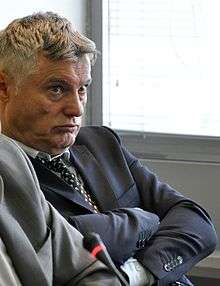Miroslav Lazanski

Miroslav Lazanski (Serbian: Мирослав Лазански, born 1950) is a Serbian politico-military writer, correspondent and commentator for the Belgrade daily Politika.[1]
Early life
Born in Karlovac, PR Croatia, FPR Yugoslavia to a Slovenian father who got assigned to Karlovac as a Yugoslav People's Army (JNA) officer and Serb mother, Lazanski completed primary school in the town of his birth. His paternal family is of Polish origin.[2] His grandfather and uncle were killed in the Jasenovac concentration camp held by the Ustashe during World War II.[3] During the war, his father, at the time a Royal Yugoslav Army officer, was held at Osnabruck as a prisoner of war.[3] His father's best friend was Zoran Konstantinović (1920–2007). His father's job took the family to Trebinje where Lazanski went to gymnasium. He had military service in Bitola in 1977, in the 41st infantry division of JNA.[2] Upon graduating he enrolled at the University of Zagreb's Faculty of Law and graduated.
Career
Vjesnik, Danas, and Start
Lazanski's first jobs in journalism were for the Vjesnik daily newspaper and the Danas and Start weekly news magazines in Zagreb. He is a writer of numerous books.
He reported from the scene of armed conflicts such as the Soviet–Afghan War, the Iran–Iraq War, the Lebanese Civil War, and the Gulf War. Furthermore, he managed to obtain exclusive interviews with some of the leading global military figures of the period such as US Army general Bernard W. Rogers in October 1982 (who at the time performed the role of NATO's Supreme Allied Commander Europe) as well as Soviet Army general Sergey Akhromeyev in December 1982 who was about to become a Marshal.
Other figures Lazanski interviewed included John Galvin, Warsaw Pact commander-in-chief Viktor Kulikov in 1986, Soviet Minister of Defense Dmitry Yazov in 1988, Soviet Navy commander-in-chief admiral Vladimir Chernavin, KGB chief general Vladimir Kryuchkov, Igor Radionov, Bennie L. Davis, Paul Sper, Crosbie E. Saint, Huntington Hardisty, Sir John Woodward, James Alan Abrahamson, Johan Jørgen Holst, Ferenc Kárpáti, Vasile Milea, Dobri Dzhurov, Shahnawaz Tanai, Maher Abdul Rashid, Helmut Willmann, Guido Venturoni, Joe Modise, Georg Meiring, etc.
While he was writing for different Balkan publications, Lazanski's articles were also published in the Greek newspaper Kathimerini and the Japanese newspapers Diamond Weekly and Securitarian.
Speaking in September 2014 about his methods of access to military officials on both sides of the Cold War, Lazanski said:
| “ | I used the circumstances of the Cold War and the fact that SFR Yugoslavia was non-aligned, meaning that it was neither a part of NATO nor part of Warsaw Pact. Many of the interviews I scored in the Soviet Union came about because top Soviet military officials wouldn't communicate directly with the Western media, but they would talk to a Yugoslav journalist for a Yugoslav newspaper or magazine knowing full well that interview would later be carried by a Western publication. As far as the Western military brass went, getting them to talk for a Yugoslav media outlet was never an issue. They very much wanted to address the Yugoslav public as part of their overall PR effort.[4] | ” |
Politika
In February 1991 Lazanski took an offer from Politika to become their commentator and moved to Belgrade. He remained at the job until fall 1995.
He reported from the Yugoslav Wars including the Ten-Day War, Croatian War, Bosnian War, and Kosovo War as well as the First Chechen War, Libyan Civil War, and Crimea Crisis.[5] He has authored several books.
Film
Lazanski was interviewed in Boris Malagurski's documentary film The Weight of Chains 2 (2014).
Personal
Lazanski is related to former president of Republika Srpska Biljana Plavšić, his maternal grandmother and Plavšić's father being siblings (Lazanski's mother and Plavšić are cousins).[6]
He is married to a Serbian woman from Belgrade.[2]
References
- ↑ "II. Country Assessments". State.gov. Retrieved 2011-07-24.
- 1 2 3 Ona magazin.
- 1 2 "Događanje Jasenovca".
- ↑ Ćirilica;Happy TV, 1 September 2014
- ↑ Crimea Report on Politika Newspaper website
- ↑ "ЛАЗАНСКИ: Лепо сам јој рекао – тетка кад изгубиш власт, завршићеш у Хагу".
Further reading
- "Istina se plaća" (PDF). Ona magazin. 19 March 2013.